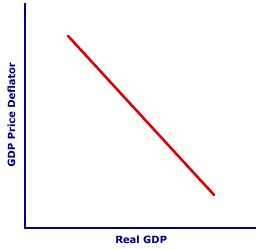
|
|
AD: The abbreviation for aggregate demand, which is the total (or aggregate) real expenditures on final goods and services produced in the domestic economy that buyers would willing and able to make at different price levels, during a given time period (usually a year). Aggregate demand (AD) is one half of the aggregate market analysis; the other half is aggregate supply. Aggregate demand, relates the economy's price level, measured by the GDP price deflator, and aggregate expenditures on domestic production, measured by real gross domestic product. The aggregate expenditures are consumption, investment, government purchases, and net exports made by the four macroeconomic sectors (household, business, government, and foreign).
Visit the GLOSS*arama
|
|


|

|
                           CHANGE IN AGGREGATE EXPENDITURES: The movement along an aggregate demand curve caused by a change in the price level. A change in aggregate expenditures is ONLY caused by a change in the price level. This is one of two changes related to aggregate demand. The other is a change in aggregate demand. A change in aggregate expenditures is comparable to a change in quantity demanded. A change in aggregate expenditures is a movement along a given aggregate demand curve. In contrast, a change in aggregate demand is a shift in the aggregate demand curve.To better understand the meaning of a "change in aggregate expenditures," note the difference between two similar concepts--aggregate demand and aggregate expenditures. Aggregate demand is the whole range of price levels and expenditures on real production while aggregate expenditures is the specific expenditures undertake at a specific price level. Aggregate demand is the entire aggregate demand curve, while aggregate expenditures are represented by a specific point on a given aggregate demand curve. So what does it mean to add the phrase "change in" to aggregate demand and aggregate expenditures? A "change in" aggregate expenditures means that a NEW price level-aggregate expenditures combination has been identified on the existing aggregate demand curve. In contrast, a "change in" aggregate demand means that the entire aggregate demand curve has changed, moved, or shifted; that the whole range of price levels and aggregate expenditures have changed. | Change in Aggregate Expenditures | 
|
This exhibit to the right displays a standard aggregate demand curve. Two buttons are displayed beneath this graph. One, labeled [Price Level], illustrates a price level-induced change in aggregate expenditures. For comparison purposes, the other, labeled [Determinant], demonstrates a determinant-driven change in aggregate demand. A click of the [Price Level] button triggers a movement along the aggregate demand curve. A click of the [Determinant] button triggers a shift of the aggregate demand curve, in particular, and rightward shift representing an increase in aggregate demand. Why is this difference so important? The answer is as simple as cause and effect. The aggregate demand curve is used (together with the long-run and short-run aggregate supply curves) to explain and analyze macroeconomic events, especially business-cycle instability. The sequence of events follows a particular pattern. - First, a determinant (of either aggregate demand or aggregate supply) changes.
- Second, this determinant change causes the aggregate demand curve or one of the aggregate supply curves to shift. An aggregate demand determinant change causes a shift of the aggregate demand curve and an aggregate supply determinant change causes a shift in one of the aggregate supply curves.
- Third, the change in aggregate demand or aggregate supply causes an imbalance in the aggregate market (an economy-wide shortage or surplus). The aggregate market is in a temporary state of disequilibrium.
- Fourth, the economy-wide shortage or surplus causes the price level to change.
- Fifth, the change in the price level causes a change in aggregate expenditures and possibly real production.
- Sixth, the changes in aggregate expenditures and/or real production eliminate the shortage or surplus and restore equilibrium.
The key conclusion is that aggregate demand (and aggregate supply) determinants, which induce changes in aggregate demand (and aggregate supply), are the source of instability in the aggregate market. The change in the price level, which induces a change in aggregate expenditures (and real production) is the means of eliminating the instability and restoring equilibrium.

Recommended Citation:CHANGE IN AGGREGATE EXPENDITURES, AmosWEB Encyclonomic WEB*pedia, http://www.AmosWEB.com, AmosWEB LLC, 2000-2024. [Accessed: April 27, 2024].
Check Out These Related Terms... | | | | | |
Or For A Little Background... | | | | | | | | | | |
And For Further Study... | | | | | | | | | | |
Search Again?
Back to the WEB*pedia
|



|

|
RED AGGRESSERINE
[What's This?]
Today, you are likely to spend a great deal of time surfing the Internet trying to buy either a flower arrangement with daisies and carnations for your uncle or a coffee cup commemorating next Thursday. Be on the lookout for slightly overweight pizza delivery guys.
Your Complete Scope
This isn't me! What am I?
|

|
|
The first "Black Friday" on record, a friday marked by a major financial catastrophe, occurred on September 24, 1869 -- A FRIDAY -- when an attempted cornering of the gold market induced a financial crises and economy-wide depression.
|

|
|
"Nothing is a waste of time if you use the experience wisely. " -- Auguste Rodin, Sculptor
|

|
ARIMA
Autoregressive Integrated Moving Average
|

|
|
Tell us what you think about AmosWEB. Like what you see? Have suggestions for improvements? Let us know. Click the User Feedback link.
User Feedback
|


|


